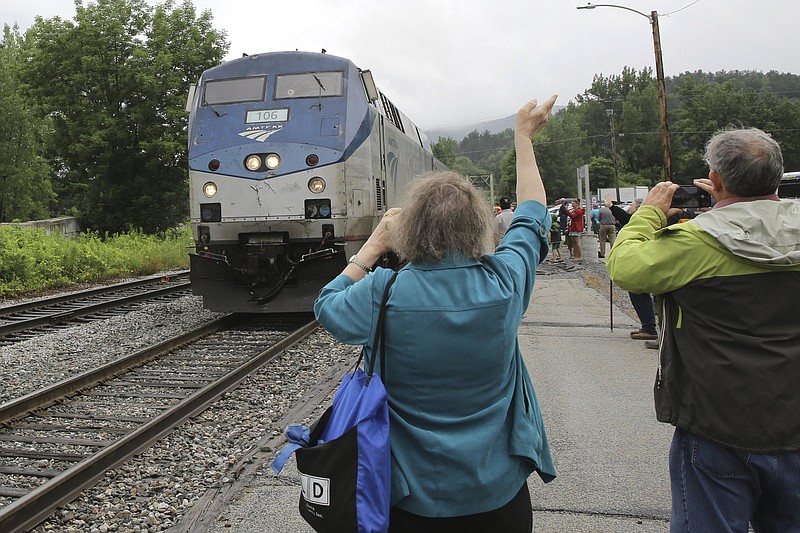WASHINGTON -- More people have traveled by passenger rail this summer than any point since the start of the pandemic, signaling that trains are following airlines on a path to recovery despite a recent rise in coronavirus cases.
The latest numbers are the best news in nearly 18 months for Amtrak, which was hit hard by the pandemic and forced to rely on federal aid to stay afloat.
More than 1.8 million people traveled by Amtrak in July -- the busiest month since ridership plummeted earlier last year -- building on June's passenger count of 1.5 million. The numbers represent a resurgence for America's passenger railroad, coming on the heels of road traffic hitting pre-pandemic levels in much of the country and surging demand for air travel.
Historically dependent on business travel in the Northeast Corridor, Amtrak is counting on a mix of new customers, promotional fares and a message of pandemic-era safety to lure riders back.
[CORONAVIRUS: Click here for our complete coverage » arkansasonline.com/coronavirus]
While an upward trend in bookings might be evidence of a turnaround, ridership continues to fall short of 2019 levels. Travel aboard Amtrak is about 35% below pre-pandemic numbers.
A busier railroad during the summer months also has presented challenges in Amtrak's ability to enforce a federal mask mandate aboard trains and in stations. Amtrak in recent months has seen a spike in incidents involving passengers refusing to comply.
Though cases of mask defiance on the rails don't garner the same attention as disruptions in the skies, railroad officials said the confrontations have similarities.
"If we do have someone who's difficult, we stop at the next station and we remove them," said Roger Harris, Amtrak's chief marketing and revenue officer. "And since we stop every 10 or 20 minutes, it's not like landing a plane and it's not as disruptive."
For Amtrak, which saw ridership plummet 97% in the weeks after the pandemic, ensuring smooth operations and maintaining coronavirus safety protocols are key to luring back passengers.
The railroad has been slower than airlines in rebuilding ridership, partly because the busy Northeast Corridor relies on lucrative business travel, which continues to lag.
Amtrak's strategy coming out of the pandemic has been to lure leisure travelers with ticket sales -- a price structure that has proven key to the summer's rebound. Seats on would-be empty trains, generally outside peak travel hours, are being sold at reduced prices to a new set of passengers.
Passenger counts are also up for Amtrak's premium Acela service, primarily used for corporate trips before the pandemic. Seats on Acela trains from Washington D.C. to New York sold for as much as 70% below normal fares earlier this summer.
The company announced it has attracted about 300,000 new customers a month while it is beginning to see previous customers return.
A surge in coronavirus caseloads from the more transmissible delta variant in recent weeks has not had a large effect on rail travel, Amtrak officials said.
Some airlines in recent days have reported weaker bookings and increases in cancellations attributed to the delta variant. Amtrak disclosed it has seen a modest increase in people using fare flexibility options to change travel dates in recent weeks.
Beth Osborne, director of the D.C.-based nonprofit advocacy group Transportation for America, said downs and ups are likely as long as spikes in coronavirus cases continue. The good news, she said, is the pandemic is leading companies such as Amtrak to rethink services to attract new types of travelers.
While a large share of the railroad's services rely on East Coast business travel, the railroad has been marketing to new prospective customers, including running campaigns targeting Spanish-speakers and other minority communities.
"I really do think that Amtrak and the federal government has to do a better job of advertising how much is being done to make it safe," said Osborne, who recently took the Acela on a family trip to New York.
HIGHER STANDARD
Transit systems across the nation are being held to a higher standard of cleanliness, ventilation and public health, she said, noting that masks are required across transportation systems via a mandate by the TSA.
Passengers traveling by Amtrak also must submit a health questionnaire, answering questions such as whether they have experienced covid-19 symptoms within 24 hours of departure. The company's 18,000 employees are required to be vaccinated or submit to weekly testing, effective Nov. 1.
William K. Bolan, 25, of Arlington, Va., took the Northeast Regional train to Baltimore for a day trip earlier this month. He had not traveled by train since the pandemic began.
"I got tired of not being able to do anything and go anywhere," he said. "I realized, 'Wait a minute, I got no work, I got some money in my pocket, I'm going to do this.'"
Bolan said he is vaccinated and felt comfortable getting on the full train car the morning of Aug. 14.
"I know that they have safety measures in place, and I felt perfectly fine," he said.
And at $13 each way, he said, "it was very cheap for me."
